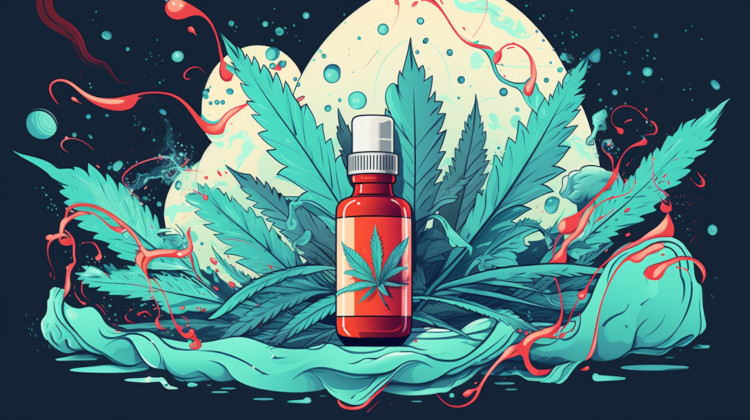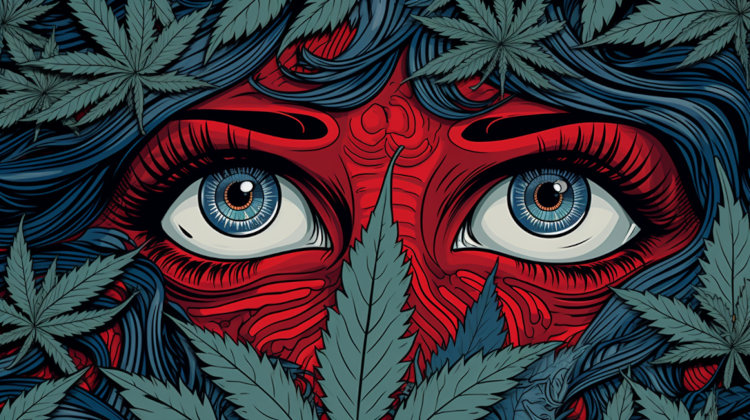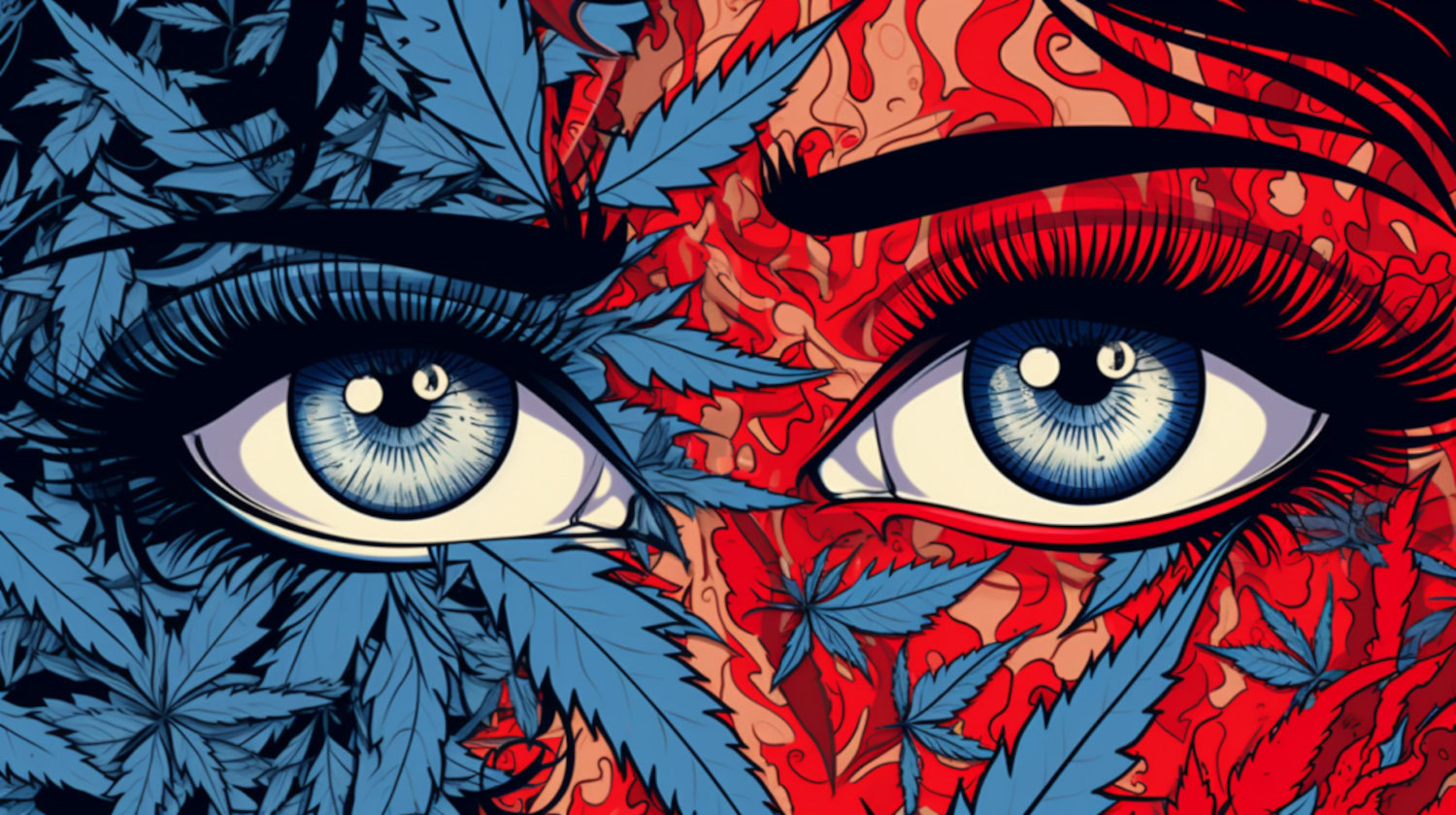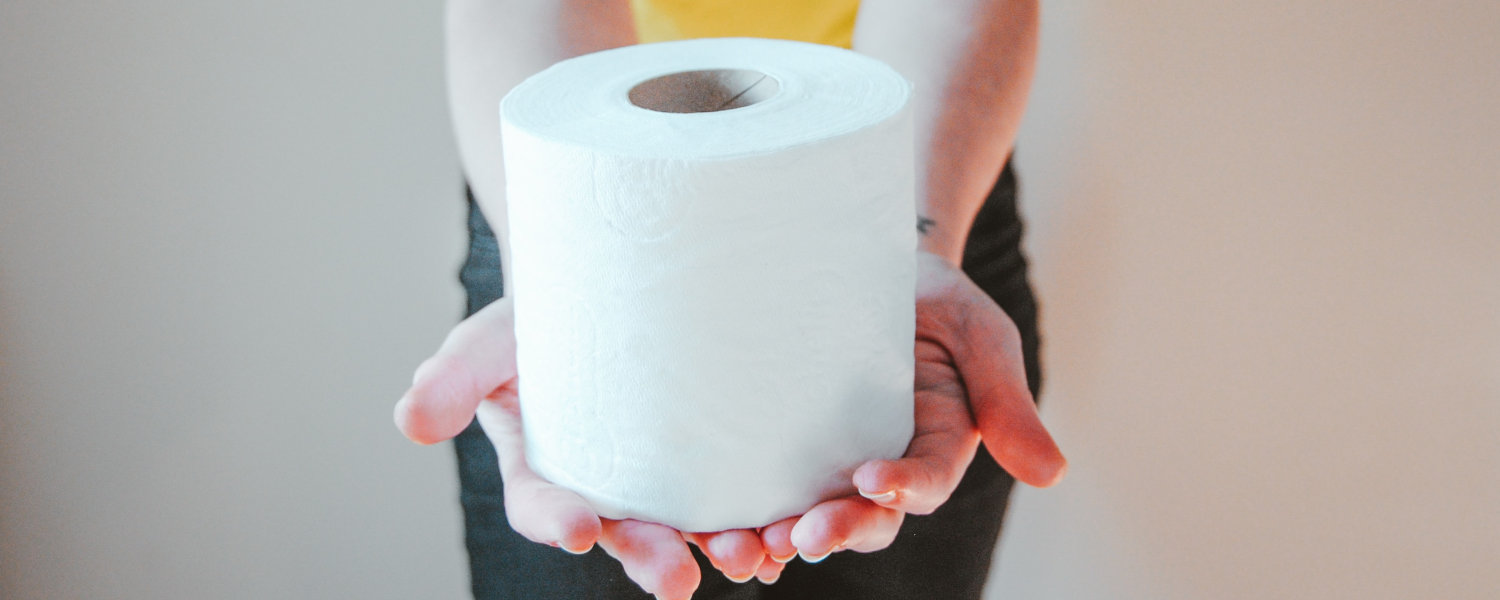Key Takeaways
- CBD may cause eye-related side effects, including dryness, irritation, and potential changes in eye pressure.
- CBD’s impact on vision is less clear than the effects of THC on vision.
- Unregulated CBD products pose a risk for consumers.
Your eyes can reveal a lot about your health and well-being. Beyond showing emotions, happy or troubled, your eyes can serve as medical indicators of how well or poorly your entire system is functioning. Changes in eye appearance or vision quality are often the first signs of illness.
Emerging medical research focuses on how cannabidiol (CBD) might target health concerns, including eye health. While cannabis and THC are known to help eye conditions, CBD is a little trickier. Given the importance of our eyes, it’s worth considering the cannabinoid's benefits and weighing possible CBD side effects on the eyes.
What is CBD?
CBD is a cannabinoid, one of the naturally occurring compounds in cannabis. It's legal in all US states, including the District of Columbia, and medically accepted for being generally safe.
Unlike THC, CBD is non-intoxicating, so users may get relief without feeling spacey or euphoric. The risk of overdose is practically non-existent – no one has ever overdosed on CBD or any other natural form of cannabis.
More than 60% of adults have used CBD.1 Research confirms it shows promise in treating psychotic disorders, anxiety, epilepsy, sleep disorders, cardiovascular diseases, diabetes, pain management, and even cancer treatment.2
Only one pharmaceutical CBD drug, Epidiolex, is FDA-approved for specific conditions. Still, CBD-infused products (including lip balms, beverages, vapors, edibles, topicals, essential oils, and so on) are widely available over the counter.
Although CBD is well-tolerated, some side effects can include sedation, loss of appetite, diarrhea, fatigue, and sleep disturbances.3 CBD may interact with certain prescription medications, so it’s a good idea to check with your doctor or pharmacist before starting CBD.4
CBD Oil’s Side Effects on the Eyes

Cannabinoid receptors communicate with the endocannabinoid system throughout the body, including the eyes. Cannabinoids, like CBD, stimulate the receptors in the eyes and the areas of the brain that control vision and eye health.5
Some people experience eye-related side effects when using CBD oil. Research shows CBD oil can produce eye side effects ranging from mildly annoying to those that require medical guidance.
Dry or irritated eyes may result from allergic reactions to CBD or components in CBD oil. Although rare, allergy symptoms can manifest as eye redness, itching, or swelling. If allergic reactions following the use of a CBD product become severe or painful, a healthcare professional should review the use.
Many CBD products will contain a small amount of THC, up to 0.3%, as allowed under the 2018 Hemp Bill. Depending on the dosage and patient sensitivity, this can cause mild intoxicating effects. THC may influence perception and affect vision in higher doses.6
Does CBD Cause Eye Pressure Changes?
The relationship between CBD and eye pressure (intraocular pressure or IOP) is a primary area of interest to ophthalmologist physicians who treat eyes. Inside the eyeball, this balance of eye fluid under pressure maintains the perfect shape of the eye. If this ocular or eye pressure is too low or too high, it can cause problems with vision.
For example, elevated IOP is a risk factor for glaucoma, which can lead to optic nerve damage and vision loss. Initial impact studies on CBD and eye pressure have conflicting results. One report suggests that CBD may raise IOP, which could be detrimental for individuals with glaucoma.7 Yet another research team found no proof that CBD had any effect on eye pressure.8 These conflicting conclusions ensure continued research on CBD and eye pressure disorders.
Changes in blood pressure and flow can affect the optic nerve and overall eye health, especially those with vision problems. Since CBD can lower blood pressure, eye researchers are looking into the significance of CBD’s impact on ocular pressure.9
CBD vs THC for Glaucoma
Concerns about CBD, THC, and eye health center around intraocular pressure (IOP), which is a primary cause of glaucoma.
Glaucoma is a group of eye conditions that cause damage to the optic nerve, often resulting from unmanaged and elevated IOP. The affected optic nerve can’t transmit images to the brain. It’s a significant cause of blindness, affecting around 3 million people in the United States alone.
Researchers in the early 1970s discovered THC’s ability to reduce ocular pressure, and it offered better results than any other available glaucoma treatments at that time. Today, both THC and lab-created synthetic cannabinoids are used to reduce eye pressure in glaucoma patients significantly.10
On the flip side, other studies show that scientists don’t have a clear answer on whether CBD increases, decreases, or has any effect on IOP. However, one cannabis study found CBD raised eye pressure while it blocked the positive IOP pressure-lowering of THC.5,6
Continuing research focuses on whether CBD raising ocular pressure could be a harmful side effect, especially with long-term use. Additional studies may find CBD helpful for other eye conditions like inflammation or macular degeneration.
Still, CBD has antioxidant, anti-inflammatory, and neuroprotective properties, which could be beneficial in protecting the eyes and slowing down glaucoma progression.3
Research continues on CBD’s potential benefits for glaucoma and other eye conditions like eye inflammation or macular degeneration.
An ophthalmologist doctor should be your guide on any treatment decisions for glaucoma. If cannabinoid therapies are an option, THC or synthetic cannabinoids show proven results in lowering IOP. Current studies conclude that CBD may not be effective for this.
Does CBD Make Your Eyes Red?

A common side effect of cannabis use is red eyes, but does CBD share this characteristic? The short answer is generally no — CBD alone does not typically cause red eyes. The redness in the eyes associated with cannabis use has been primarily linked to THC due to its interaction with cannabinoid receptors in the brain.6
THC lowers blood pressure, which dilates blood vessels and capillaries throughout the body, including the tiny blood vessels in the eyes. These tiny capillaries swell, partially resulting in redness or bloodshot eyes and dilated pupils. This redness can be made worse by smoke irritation.11
While CBD does have vasodilatory properties, it typically does not induce red eyes in the same manner THC does.9 However, many CBD-dominant cannabis cultivars or CBD products may contain trace (or higher) amounts of THC that could lead to eye redness.
Choosing "THC-free" products and reviewing third-party lab test results to verify the THC content is a good idea for those seeking CBD products without the risk of red eyes.
Weed's Effects on Vision
Cannabis does affect vision, both in what you see and how well you see it.
Participants in a study were asked if cannabis affected their vision when high, and more than 32% said cannabis use had little or no impact on their vision and eyesight. However, test results on participants while they were under the influence of cannabis told a different story.
Researchers tested the study group on a wide variety of visual assessment tests before smoking cannabis. Patients were tested again following the administration of cannabis. In every category, participants' results showed a negative impact on their vision vs the pre-consumption baseline.
Post-cannabis use, vision changes occurred through:
- Stereo acuity, or the eye’s ability to see in three dimensions. Judging the distance to a stop sign or the depth of a curb on a city sidewalk can be difficult without depth perception.
- Static visual acuity, the vision needed to see a non-moving object, like an eye chart clearly, was also reduced.
- Lower tear production and less frequent blinking create an uneven surface to the eye that bends the light and distorts vision.6
- Difficulty in changing focus between close and near objects, as cannabis affects receptors in the eye's retina, causing the brain to receive distorted signals and making it harder to see things clearly.12
These effects are typically short-lived and subside as the intoxicating effects of THC wear off.
Does CBD have the same impact on vision as THC-rich cannabis?
When it comes to CBD, the non-intoxicating cannabinoid, the impact on vision is less clear. While CBD doesn’t induce the same changes in sight associated with THC, some research suggests it may affect eye pressure, a concern for individuals with glaucoma or other eye conditions.
One case tells of a 57-year-old woman who became hyperopic (farsighted) after taking CBD daily, suggesting that there might be a link between CBD consumption and changes in vision.13 However, this is a single case; more extensive clinical research is needed to draw definitive conclusions.
CBD's Side Effects on the Eyes: Balancing the Risks

While CBD may offer many potential benefits, it isn’t without side effects. Known side effects of CBD on the eyes seem limited to potential dryness, irritation from allergies, and possible eye pressure changes.
A surprising concern about CBD's safety comes from the actual products. The CBD market is largely unregulated, and untested products may have mislabeled CBD content (or none at all). Potency, therapeutic benefits, and purity claims are suspect without third-party testing.14
For example, companies that market CBD eye drops are not FDA-approved, and there is no regulation on producing these products. Using untested and unregulated products on sensitive eye tissue may have dangerous and unwanted side effects. Even companies with FDA approval face contamination concerns, as over seven different brands of eye drops are currently being recalled by the FDA over unsanitary conditions in production facilities.
To ensure the proper steps are taken for eye-related and all health concerns, speak with a healthcare provider or ophthalmologist before adding CBD into a wellness routine. Combined with regular eye exams, your healthcare provider can oversee your safe treatment and follow-up for optimal eye health.
References
- Moltke J, Hindocha C. Reasons for cannabidiol use: a cross-sectional study of CBD users, focusing on self-perceived stress, anxiety, and sleep problems. Journal of Cannabis Research. 2021;3(1). doi:https://doi.org/10.1186/s42238-021-00061-5
↩︎ - Peng J, Fan M, An C, Ni F, Huang W, Luo J. A narrative review of molecular mechanism and therapeutic effect of cannabidiol (CBD). Basic & Clinical Pharmacology & Toxicology. 2022;130(4):439-456. doi:https://doi.org/10.1111/bcpt.13710 ↩︎
- Millar SA, Maguire RF, Yates AS, O’Sullivan SE. Towards Better Delivery of Cannabidiol (CBD). Pharmaceuticals. 2020;13(9):219. doi:https://doi.org/10.3390/ph13090219
↩︎ - Brown JD, Winterstein AG. Potential Adverse Drug Events and Drug–Drug Interactions with Medical and Consumer Cannabidiol (CBD) Use. Journal of Clinical Medicine. 2019; 8(7):989. https://doi.org/10.3390/jcm8070989
↩︎ - Wang MTM, Danesh-Meyer HV. Cannabinoids and the eye. Survey of Ophthalmology. 2021;66(2):327-345. doi:https://doi.org/10.1016/j.survophthal.2020.07.002
↩︎ - Ortiz-Peregrina S, Ortiz C, Casares-López M, Jiménez JR, Anera RG. Effects of cannabis on visual function and self-perceived visual quality. Scientific Reports. 2021;11(1). doi:https://doi.org/10.1038/s41598-021-81070-5
↩︎ - Miller S, Daily L, Leishman E, Bradshaw H, Straiker A. Δ9-Tetrahydrocannabinol and Cannabidiol Differentially Regulate Intraocular Pressure. Investigative Ophthalmology & Visual Science. 2018;59(15):5904-5911. doi:https://doi.org/10.1167/iovs.18-24838 ↩︎
- Aebersold A, Duff M, Sloan L, Song ZH. Cannabidiol Signaling in the Eye and Its Potential as an Ocular Therapeutic Agent. Cellular Physiology and Biochemistry. 2021;55(S5):1-14. doi:https://doi.org/10.33594/000000371
↩︎ - Baranowska-Kuczko M, Kozłowska H, Kloza M, et al. Vasodilatory effects of cannabidiol in human pulmonary and rat small mesenteric arteries: modification by hypertension and the potential pharmacological opportunities. Journal of Hypertension. 2020;38(5):896-911. doi:https://doi.org/10.1097/hjh.0000000000002333
↩︎ - Mack A, Joy J. MARIJUANA AND GLAUCOMA. In: Marijuana as Medicine? The Science beyond the Controversy. National Academies Press (US); 2000. https://www.ncbi.nlm.nih.gov/books/NBK224386/
↩︎ - Hill M, Wong TY, Davis M, Meier MH. Associations between cannabis use and retinal vessel diameter in young adults. Schizophrenia Research. 2020;219:62-68. doi:https://doi.org/10.1016/j.schres.2019.02.016
↩︎ - Labhishetty V, Cholewiak SA, Roorda A, Banks MS. Lags and leads of accommodation in humans: Fact or fiction? Journal of Vision. 2021;21(3):21. doi:https://doi.org/10.1167/jov.21.3.21
↩︎ - Ali A, Gupta PK. Change in Refractive Error Associated With the Use of Cannabidiol Oil. Cureus. 2021;13(4). doi:https://doi.org/10.7759/cureus.14434
↩︎ - Hazekamp A. The Trouble with CBD Oil. Medical Cannabis and Cannabinoids. 2018;1(1):65-72. doi:https://doi.org/10.1159/000489287
↩︎
The information in this article and any included images or charts are for educational purposes only. This information is neither a substitute for, nor does it replace, professional legal advice or medical advice, diagnosis, or treatment. If you have any concerns or questions about laws, regulations, or your health, you should always consult with an attorney, physician or other licensed professional.




